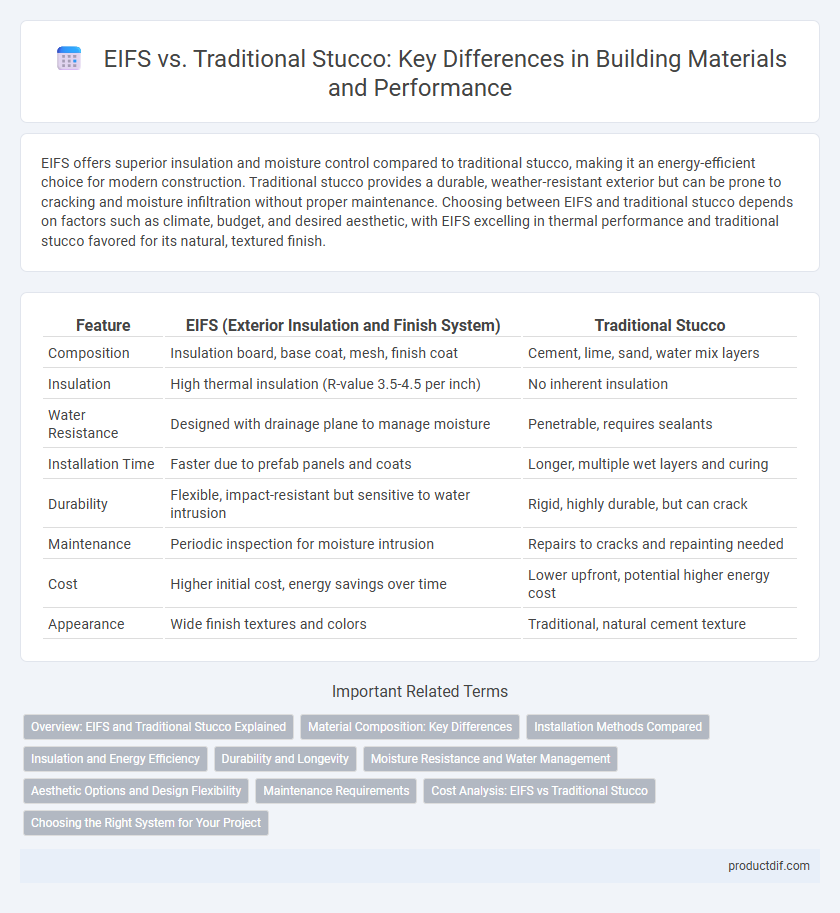EIFS offers superior insulation and moisture control compared to traditional stucco, making it an energy-efficient choice for modern construction. Traditional stucco provides a durable, weather-resistant exterior but can be prone to cracking and moisture infiltration without proper maintenance. Choosing between EIFS and traditional stucco depends on factors such as climate, budget, and desired aesthetic, with EIFS excelling in thermal performance and traditional stucco favored for its natural, textured finish.
Table of Comparison
| Feature | EIFS (Exterior Insulation and Finish System) | Traditional Stucco |
|---|---|---|
| Composition | Insulation board, base coat, mesh, finish coat | Cement, lime, sand, water mix layers |
| Insulation | High thermal insulation (R-value 3.5-4.5 per inch) | No inherent insulation |
| Water Resistance | Designed with drainage plane to manage moisture | Penetrable, requires sealants |
| Installation Time | Faster due to prefab panels and coats | Longer, multiple wet layers and curing |
| Durability | Flexible, impact-resistant but sensitive to water intrusion | Rigid, highly durable, but can crack |
| Maintenance | Periodic inspection for moisture intrusion | Repairs to cracks and repainting needed |
| Cost | Higher initial cost, energy savings over time | Lower upfront, potential higher energy cost |
| Appearance | Wide finish textures and colors | Traditional, natural cement texture |
Overview: EIFS and Traditional Stucco Explained
EIFS (Exterior Insulation and Finish System) combines insulation with a durable, weather-resistant finish, offering enhanced energy efficiency and flexibility in design. Traditional stucco consists of a cement-based plaster applied over a lath, known for its durability and breathable properties but less effective in insulation. Both systems provide aesthetic versatility and protection, but EIFS integrates modern insulation technology, making it a preferred choice for energy-conscious construction.
Material Composition: Key Differences
EIFS (Exterior Insulation and Finish System) consists of multiple layers including insulation board, a synthetic base coat embedded with fiberglass mesh, and a flexible acrylic finish, providing superior thermal insulation and moisture control. Traditional stucco is composed primarily of cement, sand, lime, and water, forming a rigid exterior finish that lacks insulation properties but is highly durable and impact-resistant. The key difference in material composition lies in EIFS's use of synthetic components and insulation layers versus traditional stucco's mineral-based, cementitious makeup.
Installation Methods Compared
EIFS installation involves applying multiple layers, including a foam insulation board, adhesive, a base coat with fiberglass mesh for reinforcement, and a finish coat, resulting in enhanced energy efficiency and flexibility. Traditional stucco requires a solid backing like metal lath or wire mesh attached to the substrate, followed by applying multiple plaster layers, which can be more labor-intensive and time-consuming. EIFS typically allows quicker installation and better crack resistance, while traditional stucco offers durability but demands more extensive surface preparation.
Insulation and Energy Efficiency
EIFS (Exterior Insulation and Finish System) provides superior insulation by integrating rigid foam panels that significantly reduce thermal bridging, enhancing overall energy efficiency in building envelopes. Traditional stucco lacks built-in insulation, relying solely on its dense cementitious layer, which offers minimal thermal resistance compared to EIFS. Buildings with EIFS typically experience lower heating and cooling costs due to better temperature regulation and improved energy performance.
Durability and Longevity
EIFS (Exterior Insulation and Finish System) offers enhanced insulation and moisture resistance compared to traditional stucco, leading to improved durability in varying climates. Traditional stucco, composed of cement, sand, and lime, typically lasts 50 to 80 years but is prone to cracking and water infiltration if not maintained properly. Properly installed EIFS can extend building lifespan by preventing moisture damage and thermal bridging, making it a more resilient option for long-term exterior wall protection.
Moisture Resistance and Water Management
EIFS (Exterior Insulation and Finish Systems) offers superior moisture resistance compared to traditional stucco due to its integrated drainage plane and water-resistant barrier, which effectively channel water away from the substrate. Traditional stucco relies on a dense, multi-coat application that can trap moisture, leading to potential water infiltration and damage over time. Proper installation of EIFS significantly reduces the risk of water intrusion and mold growth, enhancing the building envelope's durability and energy efficiency.
Aesthetic Options and Design Flexibility
EIFS offers a wider range of aesthetic options and design flexibility compared to traditional stucco, allowing for various textures, colors, and finishes that can mimic stone, brick, or wood. Its lightweight, synthetic composition enables easier customization and integration of insulation, enhancing both the appearance and energy efficiency of buildings. Traditional stucco, while durable, is more limited in texture and color variety, often requiring additional treatments to achieve similar design versatility.
Maintenance Requirements
EIFS requires less frequent maintenance than traditional stucco due to its flexible, impact-resistant design that reduces cracking and water infiltration. Traditional stucco often needs regular inspections and repairs to address cracks, water damage, and paint deterioration. Proper upkeep of EIFS involves routine cleaning and resealing, while traditional stucco demands more intensive patching and repainting to maintain its integrity.
Cost Analysis: EIFS vs Traditional Stucco
EIFS offers a lower initial installation cost compared to traditional stucco, with savings typically ranging from 20% to 30% due to its lightweight components and quicker application process. While traditional stucco requires multiple layers and longer curing times, increasing labor costs, EIFS systems minimize these expenses through factory-produced panels and faster drying. Long-term maintenance of EIFS can also be more cost-effective, as it provides enhanced insulation and moisture protection, potentially reducing energy bills and repair costs over time.
Choosing the Right System for Your Project
EIFS offers superior insulation and moisture control compared to traditional stucco, making it ideal for energy-efficient buildings in regions with extreme climates. Traditional stucco provides a durable, low-maintenance finish ideal for historic restoration or projects requiring a classic appearance and high impact resistance. Selecting the right system depends on project requirements such as thermal performance, aesthetic preference, climate conditions, and budget constraints.
EIFS vs Traditional Stucco Infographic

 productdif.com
productdif.com